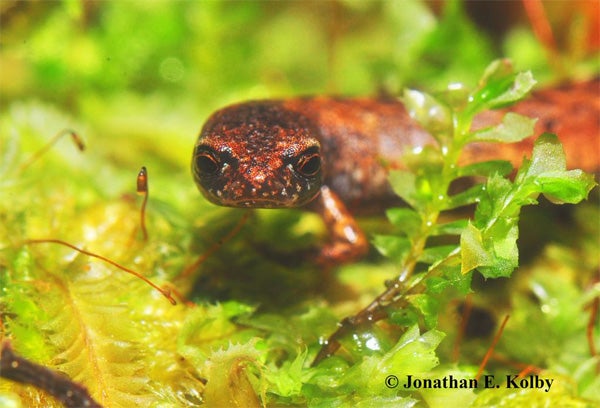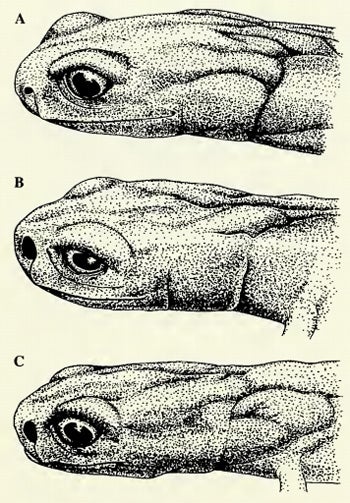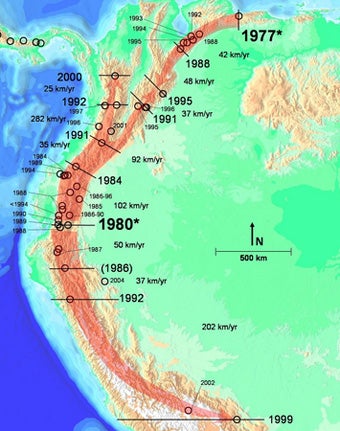This article was published in Scientific American’s former blog network and reflects the views of the author, not necessarily those of Scientific American
I must have said that one of my aims here at Tet Zoo is to write about obscure amphibian species that rarely get covered elsewhere. The main thing stopping or slowing this plan concerns the availability of images – good, available pictures showing the species concerned are often not available. Anyway, through the good graces of Jonathan Kolby, I here present an image of the extremely rare tropical American plethodontid salamander Nototriton brodiei of Guatemala and Honduras. The animal is known from less than ten specimens.

Nototriton brodiei Campbell & Smith, 1998. Image (c) J. E. Kolby, CC BY-SA.
N. brodiei is an inhabitant of subtropical wet forest where it climbs on vegetation and rock banks. It isn’t the only Nototriton species: there are currently 17 in the genus, sometimes called the moss salamanders. They're tiny, total lengths being less than 50 mm. Like so many Central and South American plethodontids, they’re relative newcomers on the herpetological scene. Nototriton itself was only named in 1983 when Wake & Elias (1983) opted to remove the group from Chiropterotriton, all Nototriton species are 20th and 21st century discoveries, and 13 of the species (13!) have been named since 1993.
On supporting science journalism
If you're enjoying this article, consider supporting our award-winning journalism by subscribing. By purchasing a subscription you are helping to ensure the future of impactful stories about the discoveries and ideas shaping our world today.

Head anatomy of three Nototriton species from Guatemala. (A) N. brodiei, (B) N. wakei, (C) N. monzoni. Head length in these animals is 5-6 mm. Image from Campbell & Smith (1998).
N. brodiei is among these very recent discoveries, having been named in 1998 when Campbell & Smith (1998) reported it from the Sierra de Caral in Guatemala (the holotype was actually collected in 1994). A second population was later reported from Cusuco National Park in Honduras by Kolby et al. (2009). Numerous later sampling efforts have turned up just one additional individual, found in 2008 (Kolby, in IUCN SSC Amphibian Specialist Group 2014).
The species of Nototriton vary with respect to head width, the proportional length of their bodies, limbs and extremities. The shorter-limbed species seem to be semi-fossorial salamanders that live in leaf-litter, burrow in soil and inhabit tunnels in rotten wood already made by beetles. N. brodiei is a member of this group and all the specimens that have been seen or collected have come from the ground (Campbell & Smith 1998). Meanwhile, the longer-limbed group (they also have shorter bodies and larger hands and feet) are virtually always associated with arboreal bromeliads and specimens are often observed or collected some distance from the forest floor... by “some distance”, I mean within a metre or so, at least.
On phylogeny, Nototriton is part of the bolitoglossine group, and (probably) related in particular to Dendrotriton, Cryptotriton, Bradytriton and Oedipina. Oh, the exact content and meaning of the term ‘bolitoglossine group’ has changed quite a bit in recent years as views of plethodontid phylogeny have evolved, but here I use the term in the strictest sense. Plethodontid phylogeny is complicated. So many lineages.

Cropped map of north-western South America charting the spread of Bd documented across the region. Image from Lips et al. (2008). Image CC.
Anyway, let’s finish with the depressing news that N. brodiei is in potential danger from habitat loss and other factors. Illegal logging occurs at the locality where it was discovered (Sierra Caral), and habitat change related to the encroachment of cattle ranching is a concern. The link with illegal timber extraction is something we can all raise awareness of – always be sure to check the sources of the timber products you buy, and tell your family and friends to do likewise. Amphibian-killing chytrid fungus has also been reported from the region, though the impact this might have on this species is unknown.
Many of you will know of Batrachochytrium dendrobatidis or Bd, the species of chytrid linked to frog death and decline. A second species – B. salamandrivorans, the ‘salamander-eating fungus’ – was identified in Europe in 2013 where it’s caused substantial die-off in Fire salamanders Salamandra salamandra (Martel et al. 2013). There’s lots more that could be said about chytrid fungi and amphibian decline: you may know that the impact that chytrids have on salamanders in general is an area of much current research, and there are strong indications that they’re are having an impact on tropical plethodontids, a southward expansion across Central America causing the decline and disappearance of many populations (Lips et al. 2008, Cheng et al. 2011).
Finally, big thanks to Jonathan Kolby (here on twitter) for providing the image used at top that initiated the creation of this article. Jonathan is leading a citizen science project that involves documenting and charting the spread of salamander-killing chytrids. If you see or find a diseased, dead or dying salamander of any sort, photograph it and contact him.
For previous Tet Zoo articles on salamanders, see...
Spiky-frilled, lek-breeding amphibious salamanders… or ‘newts’
Coprophagy and the giraffe-neck program: more on plethodontids
The USA is still yielding lots of new extant tetrapod species
Ref - -
Campbell, J. A. & Smith, E. N. 1998. New species of Nototriton (Caudata: Plethodontidae) from eastern Guatemala. Scientific Papers of the Natural History Museum of the University of Guatemala, 1-8.
IUCN SSC Amphibian Specialist Group 2014. Nototriton brodiei. The IUCN Red List of Threatened Species. Version 2015.2. <www.iucnredlist.org>. Downloaded on 20 August 2015.
Kolby, J. E., McCranie, J. R. & Rovito, S. M. 2009. Geographic distribution. Nototriton brodiei. Herpetological Review 40, 444.
Wake, D. B. & Elias, P. 1983. New genera and new species of Central American salamanders, with a review of the tropical genera (Amphibia, Caudata, Plethodontidae). Contributions in Science. Natural History Museum of Los Angeles County 345, 1-19.